Hitch-hiking: A journey through "the happiest countries in the world"
What if hitchhiking became an interesting, outstanding, and even low cost way of travelling the world?
Hitchhiking is undoubtedly dangerous and risky, but there is also another side to it that makes it educational and unique. There is beauty to it, something exceptional and very real.
It is a way to get an insight on different people’s lives, thoughts and cultures. It can be rewarding to share a conversation with a stranger who crosses your path for just a few hours, or a day.
It is a way of knowing and getting close to the ordinary extraordinary souls that exist in this world, and that you would never meet otherwise.
Before telling you about my story, I would like to give some advice on how to make of hitchhiking an unforgettable experience and not a terrible nightmare. I would suggest that you never do it alone, but always with someone that you trust and love, and if you are two women, that you never get in a car with two or more men who are unable to hide their interest. Sometimes it is a matter of just paying attention to a look, of listening to an inner feeling or sensation, to prevent you from getting in unnecessary trouble. I would also suggest that you only travel during the daylight, because there is a better chance to meet people that have good intentions. Traveling by ride at night is a lot more dangerous, for the reason that the atmosphere is more mysterious and timorous, there are few people driving and it is difficult to see.
I would like to share my story. I am a 22 year-old girl from Italy who decided to go for an internship to Central America, and in particular, to Costa Rica, for a period of seven interesting, beautiful and meaningful months. I left at the very beginning of March of this year and came back at the very end of September.
I chose this country because I wanted to challenge my ability to adapt to a new culture, experience flourishing tropical vegetation and unique animals, surf the waves on long virgin beaches and learn a new language. I had also heard that Costa Rica is a happy place, where animals and nature are highly protected and there is no army. I loved the idea of going to live in a small and very green piece of earth.
I spent six months in the North Pacific Coast of Costa Rica, and dedicated one entire month to travelling by hitchhiking with my mother. I know that it is risky, but we decided to try it together, also because Costa Rica is a very expensive country. We prepared our big rucksacks and we placed our hopes in a stretched arm and a lifted finger on a dusty roadside. Our plan was to cover most of Costa Rican and Panamanian land only by ride.
Our adventure started from the town of Tamarindo Beach, in the rural region of Guanacaste, where I had been working for the past few months as a tours seller for a surf shop. The first person to give us a ride was a black man from Colombia that worked as a cook in a local restaurant. He left us at the crossroad with the town close by and we waited maybe ten minutes until two Brazilian surfers dropped us at the entrance of the dirt road that leads to Avellanas Beach, a well-known beach for surfing. The two Brazilians were drinking a herbal tea that they had brought from their country.
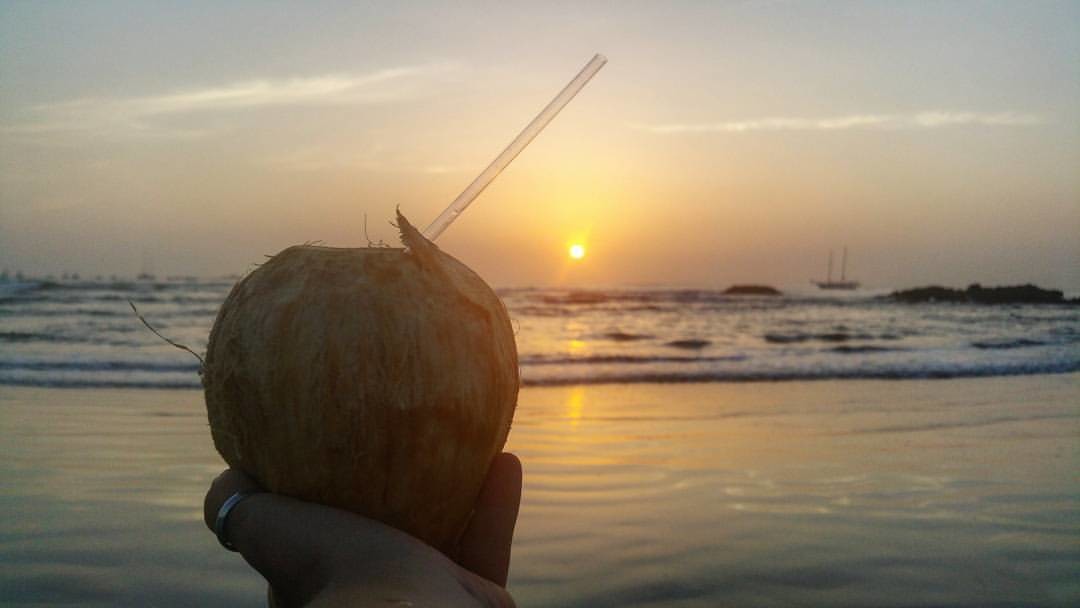

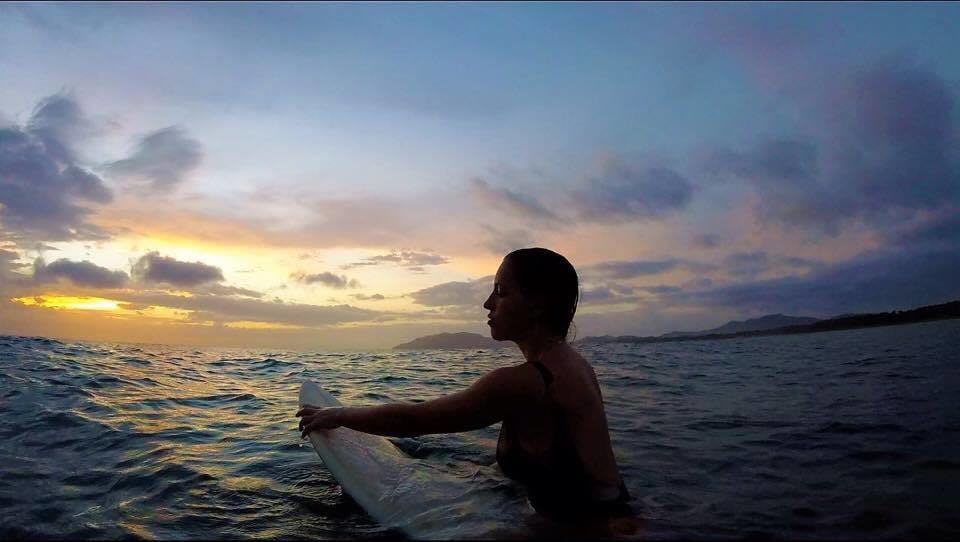
After a while, a white taxi driver from Colombia picked us up without asking for money, and drove us all the way to Nicoya, a bigger city in the Guanacaste Province, through a road that had on each side a wonderful view on Costa Rican territory and vegetation. Horses and cows were lying peacefully on the green grass and small houses would pop up along the whole road. Our objective for that day was to get to Montverde, a protected cloud forest covered with fog every day of the year and for this reason home to many endemic species. It is a known breeding ground for the Quetzal Birds.
From Nicoya to the entrance of Montverde, my mom and I had the enormous chance to find a ride with a local religion teacher originally from Grecia, a small town on the inside not far from the capital. He was in the company of his younger daughter that had long and wavy black hair. We spent maybe three hours with them, so we had time to talk about many things. He told us about a trip to Rome that he had gone on when he was only nineteen with other schoolmates as a gift from Pope John Paul II. It was in fact the year when the Pope had chosen and invited thirteen young religion students from each country in the world to join his place and seminary in Rome. That was the first trip overseas that he had taken, that the Pope had paid and organized for more than 2000 young boys from all over the planet. He told us that the most amazing thing was to have breakfast every day with different people: one morning with Russians, the next with Koreans, Africans, etc. I am still in contact with them, as they were awesome and visibly educated people. I can say that this meeting was one of the best that we have had in the whole journey by ride through Costa Rica and Panama.
The religion teacher dropped us on the side of the road that drives into the heart of the Montverde National Park, passing through small natural towns where wet and tropical vegetation reigns unmolested. A forest engineer from El Salvador gave us the next ride along a bumpy and dirty road. He told us that now he was teaching forest ecology at an international school in Montverde. He married a Costa Rican woman and had moved to Montverde for the teaching opportunity, but had also travelled in different places of North America. He left us in the town of Santa Elena, just a few kilometers from the cloud forest reserve. The day was gray and around the evening, a heavy tropical downpour came to whip the earth.
On the next day, we hitchhiked from Santa Elena to the reserve and once again, we had a blast. A father and his son from Switzerland drove us to the reserve and since it was the first visit for them, too, we stayed together the entire time. The father was a Swiss financial investor, while his son a steward on intercontinental flights for a Swiss Airline. In the reserve we followed a path circled by trees, lianas, all covered with a carpet of constant fog and heavy humidity. On the next day, after three days of rest, the steward had to take the flight back to Zurich from San José Airport, so that same day father and son had to go back to their hotel in the capital, and decided to give us a ride to the city.
On the road from Montverde to San José, we still had the whole afternoon to visit something so we stopped all together on the bridge that surmounts River Tarcoles, only to see more or less thirty huge crocodiles silently parked on the river bench or in the muddy water. Right after, we climbed a five kilometers dirt road in Carara National Park only to turn into a narrow path into tropical Costa Rican jungle that was about two kilometers long. We descended the steep path that reached the inside of the flourishing vegetation, green and wild, reign of animals and river beds, with the objective to reach a hidden, massive waterfall. Not many people are aware of the existence of this waterfall, or decide to ignore it, because to see it, it demands a tiring physical effort. The scorching heat and humidity make it hard to walk up and down for 5/6 kilometers inside impenetrable jungle, but the view at the end pays out for the strain. The waterfall is massive, and during rainy season, the water gushes out with very powerful force. It is during this season that waterfalls in Costa Rica reveal their entire splendor beyond compare. When we got out of the jungle, the sky was ablaze with colors, kissing it's last goodbye before disappearing into the darkness.
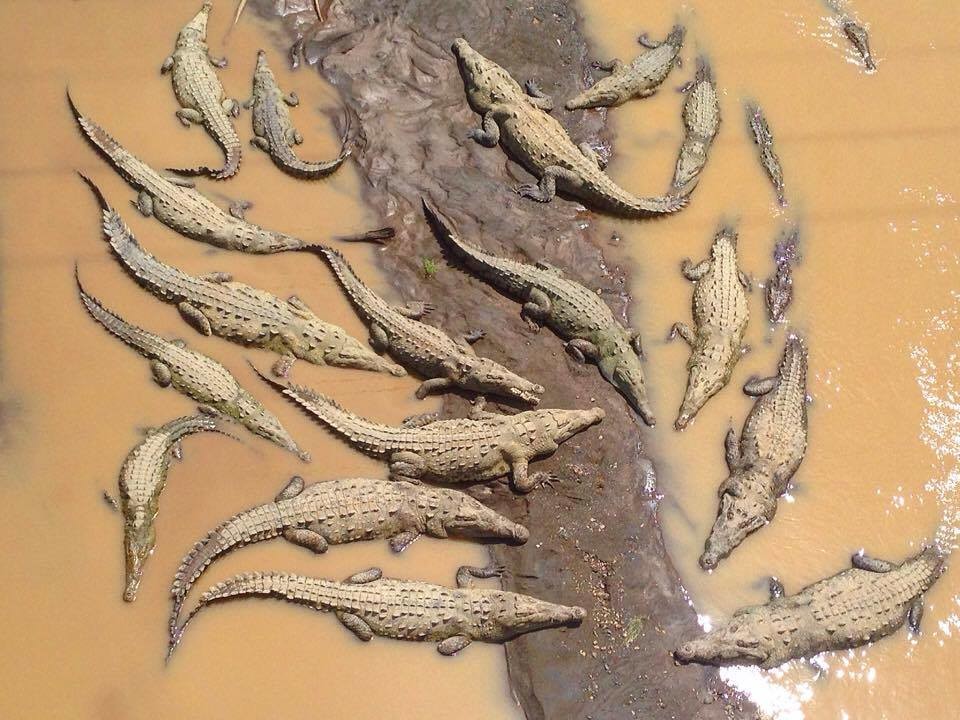
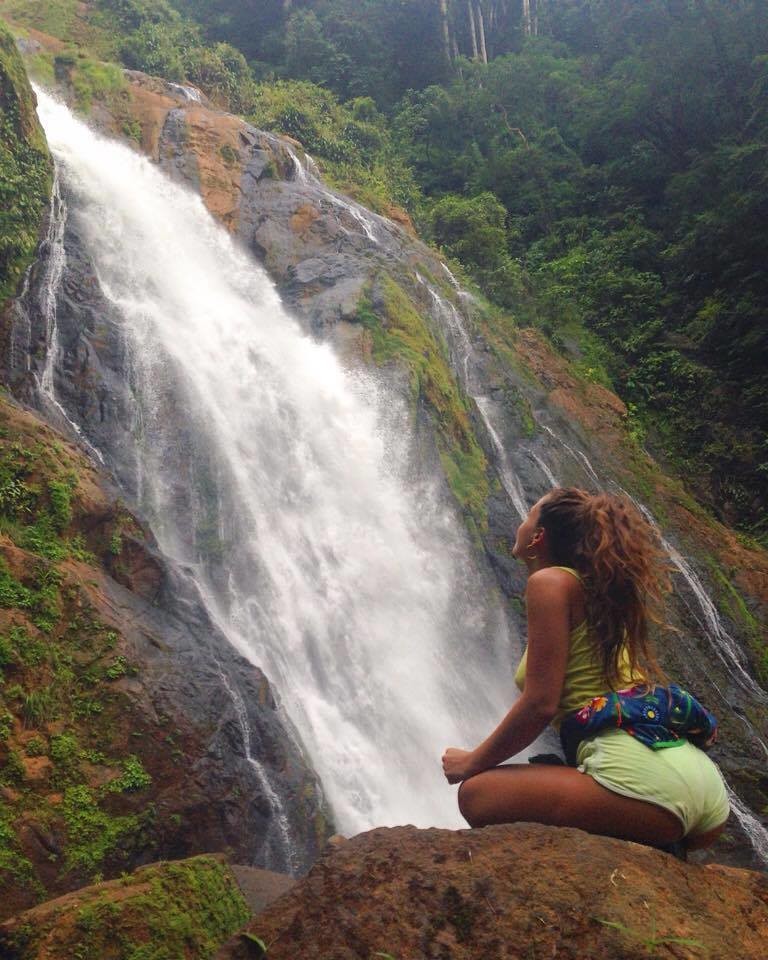
Happy and satisfied, we mounted in the car and prepared ourselves for the three-hour drive to San José. The two Swiss were such gentlemen that they accompanied us to our hostel that was in the complete center of the city, while their hotel was in Alajuela, at least one hour from the center of San José. Everyone knows what the traffic can be like on the central streets of a country’s capital, especially in a chaotic and disorderly Central American capital. However, as I said they were awesome people, so instead of leaving us in the middle of an unknown city at dark, they drove us directly in front of the place where my mom and I had to spend the night. That moment was supposed to be our last one together, but since the steward had to fly back as part of his job on the next day, and his father still had a few more days of holidays, he decided to continue his journey with us two to visit the Caribbean side of Costa Rica. We agreed to meet in front of our hostel on the next morning so that the three of us could drive to Limon, with final destination Puerto Viejo de Talamanca shortly before sunset.
On the road to Limon, we stopped only twice: once to drink a “batido” – fresh fruit mixed with water and the second one to buy a cluster of sweet mini bananas from a local fruit vendor on the main “highway” that reaches the most important - and dangerous - Caribbean harbor of Costa Rica. Along the road, we could assist at the spectacle of the luxuriant, tropical, intensely green vegetation and could already breathe the Caribbean air, more humid than the Pacific one. As we were getting closer to the city, the traffic intensified, and so did houses, stores, industrial areas, giant stored containers, camions carrying mountains of bananas, people of all colors,... On the Caribbean of Costa Rica, people are darker-skinned than those on the Pacific Coast, due to the fact that in the past many were brought in the country as slaves from Jamaica and other islands. Despite people’s opinions on the city of Limon, I did not find it so ugly or unattractive as many believe. It has a pleasant and lively center, typical of Central American cities. The market, similar to a bazaar where you can find anything that you look for, can never be missing. Stores are busy, shops are busy, food places are busy, and sidewalks. The disorderly kind of busy freezes to stare when remarkably foreign people make their way walking through the crowd. It is a wild city, as I describe it, very inflamed, where people whistle, call you, and stare at you, one that makes you feel naked and always worried about the few belongings that you carry around. The city would be very difficult for us to live in, because of it's disorganized and rough soul, for it's visible underworld. It is a pleasant place to walk through during the day because of students and old people, even because of it's chaotic essentiality and typicality, but not suggested for any reason from sunset to dawn. These areas witness the worst crimes, kidnaps and drug traffics. It is a city with a black soul, governed by drug peddlers, drug barons, and other terrible people. I only saw one woman that was reading on a bench, and for a moment, it reminded me of Europe.


After the brief walk through the center of Limon, we got back to our car and left the city, headed to the most suggestive area of the Caribbean Coast of Costa Rica. The drive was about one hour long from Limon to Puerto Viejo, along the coast. On both sides of the road, we could see again this rich vegetation made of palm trees, tall bushes, giant leaves, red flowers, lianas, banana plantations..., a reminder of the fact that Costa Rica is a green lung for the earth. We arrived in Puerto Viejo sooner than expected, and from what I could see it was as described: a touristic town, with many stalls and small shops selling summer clothes, towels, artifacts, accessories, hand-made jewelry, with the predominant colors of red, yellow and green, the colors of Bob Marley, the colors of the Caribbean! The town itself is very pretty, the beaches that characterize it are small and form tiny bays with little sand and groups of rocks in the water.
More or less two kilometers from Puerto Viejo exists one of the best beaches for surfing of the Caribbean of Costa Rica, and in general, one of the most wonderful beaches in the world: Playa Cocles. I arrived there on foot with my mom and the first thing we said was “wow! ”, because we couldn’t really see the end of it and white rough waves were crushing with force on the sand entertaining people of all ages. Only few local boys were surfing the waves, clearly the best, because the Caribbean coasts of Costa Rica are famous for the danger of rip currents, so most people were just playing in the foam or sitting in the sand. I was actually enjoying myself in the foam of the waves, too, when a local, handsome, indigenous boy whose name is Erlindes, came to talk to me. We spent some time playing in the water like kids, talking about our lives, and travels. He is one of the few Indians left on this planet, so for this reason remarkably good-looking and unique. He was tall, strong and muscular, with brown skin and long hair made up in attractive dreadlocks. He could have been the chief of his tribe, guarding his village, proudly holding a spear in his hands and fiercely hunting in the wilderness, had he been born long ago. Now he just looked like a man out of his time, an Indian who was born too late. In this present world, he is a lifeguard and a surfer, one of the many hearts stolen by the ocean’s endless beauty. He is a true Tico, swearing love to his waves and dancing off the long nights of everlasting tropical summers.
That night, I agreed to go drink some beers with him in a bar that was playing reggae music, typical of the Caribbean. We played ping-pong together and he told me about his days in Puerto Viejo, his lifeguarding job and about the love of his life: his baby daughter that lives in the United States.
On the next day the Swiss, my mom and I went to Cahuita National Park to hike a trail that boarders the sea for about two kilometers. During the hike we were able to observe white-face monkeys, lots of them, jumping from one tree to the other, visibly interested because looking for food, a sloth that was peacefully hanging from a branch, definitely not interested, and a few lizards and iguanas that would run as fast as they could in order to avoid us. Although, the best part of the day was probably swimming in the warm, shallow and crystal-clear water of the Caribbean Sea until it was time to leave and to kiss goodbye to the silent inhabitants of the Park.
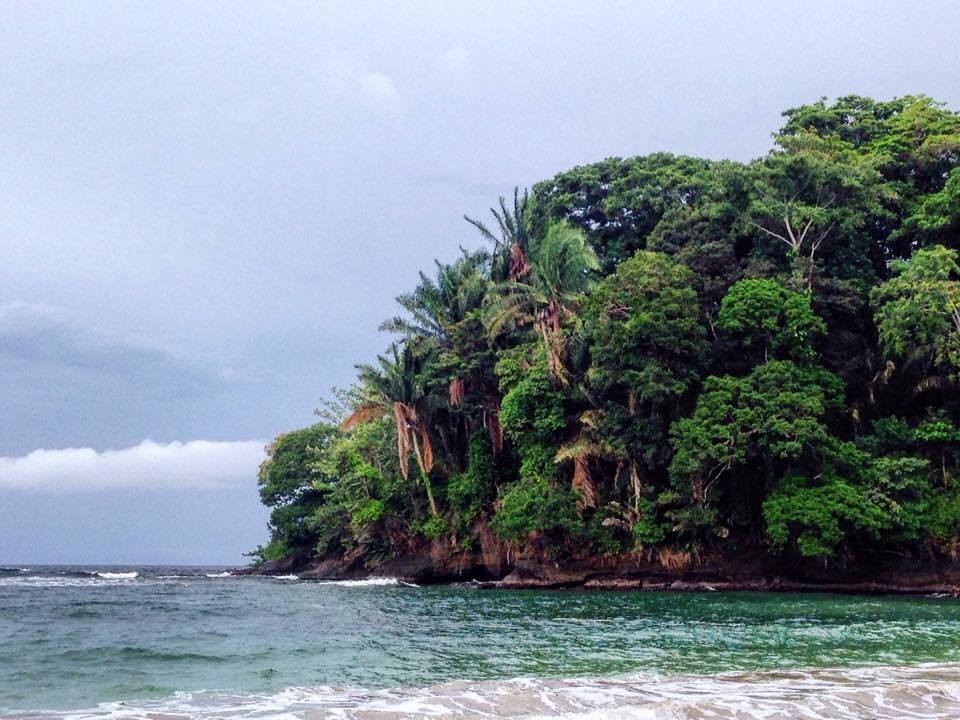
These were the last moments we spent with the Swiss because our lives separated in Puerto Viejo, as he went back to the capital and my mom and I continued our journey south. A young entrepreneur of the paper business from Guatemala drove us to the eastern frontier with the neighboring country of Panama. This man had been everywhere in Central America, he had strong political ideas and was an active fighter against the Government’s corruption. From the boarder we took an hour-long bus drive to the harbor of Almirante, where many launches were waiting to set off for Bocas Town, the most inhabited town on the main island of the archipelago of Bocas del Toro. It is one of the most visited, most breathtaking and unique sites of Central America, and of Panama.
The first thing that we visited on Colon Island was Starfish Beach, so called because it is a long narrow beach with shallow, clear water full of red and yellow starfish. The beach is located at the far end of the island, so the only way to get there is by taxi or by local bus. We took the bus, which was a small van, so for almost one hour we sat with local people from Bocas, surrounded by jungle and nothing more. From Bocas Del Drago to the beach, we mounted on an old launch conducted by an elder man with one tooth in his mouth. The water was so clear that I counted at least thirty stars, healthy and alive in their natural paradise. The area was so magnificent that I could not even believe the fact that I was there, in Panama, on an island, sharing the land of indigenous people existing every day of their lives between the warm crystal-clear ocean and the deep, impenetrable jungle.
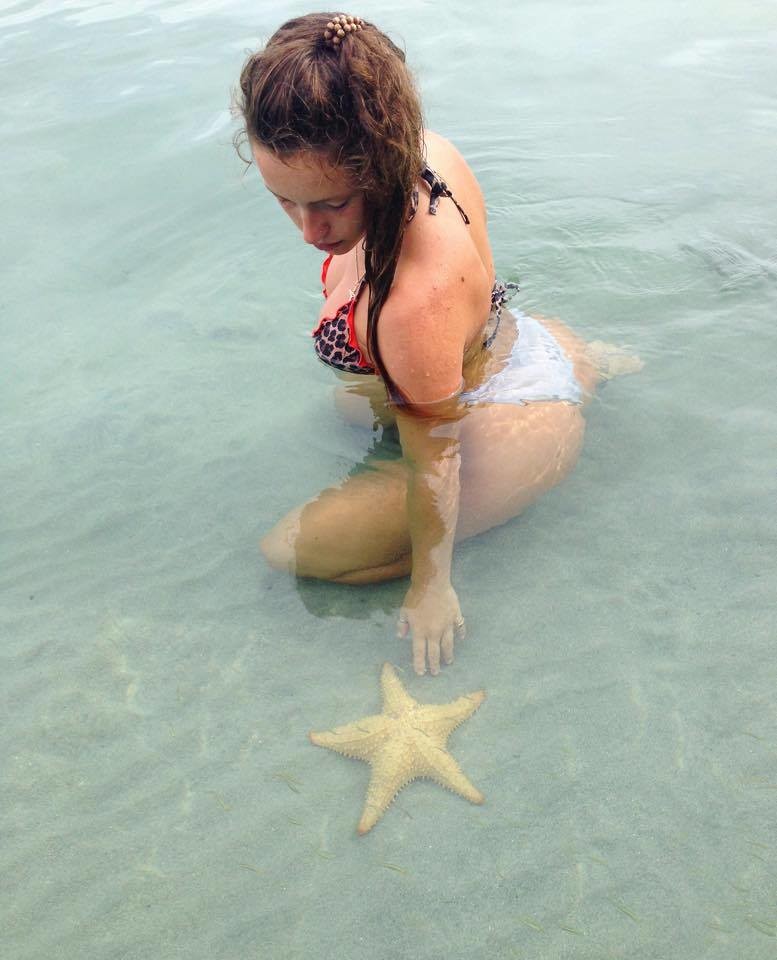

On the next day, we took a tour by boat to Dolphin Bay, Cayo Coral and Cayo Zapatilla, which are the must stop places in the archipelago of Bocas del Toro. The day was not as sunny as I hoped, but the company on the launch was great. It was a big family composed by a couple with four kids and a friend of theirs. He was a hulking of albino man from the United States, while she was Panamanian and her kids were all dark-skinned and very beautiful. The two boys had both an unusual haircut, one with tiny braids and the other with thick brown curls. In Dolphin Bay, we could see dolphins jumping all around us, next to our boat, but the sky was not on our side as it became darker and darker. When we got to Cayo Coral, a place with incredibly clear water and one very simple restaurant built up like a pile dwelling above the water, it started pouring down very hard, so hard that even the two red parrots that were flying freely on the close branches, disappeared. When the storm left, we went to Cayo Zapatilla, an idyllic round piece earth with perfectly yellowish sand, stretched-out-to-the-sky palm trees, and smiling light-blue Ocean. We sipped a beer on the sand, swam in the blue, breathed in the tropical weather, knowing it would not last too long. This super small island gave me the most valuable gift that I could have hoped for: a marine turtle, so tiny that I could hoist it in the palm of my hand, was bravely trying to reach the ocean like a little warrior with it's mini paws, ready to grow strong among the ferocious dangers of the world. I wished her to live a long life, and kissed her goodbye until I saw her for the last time.
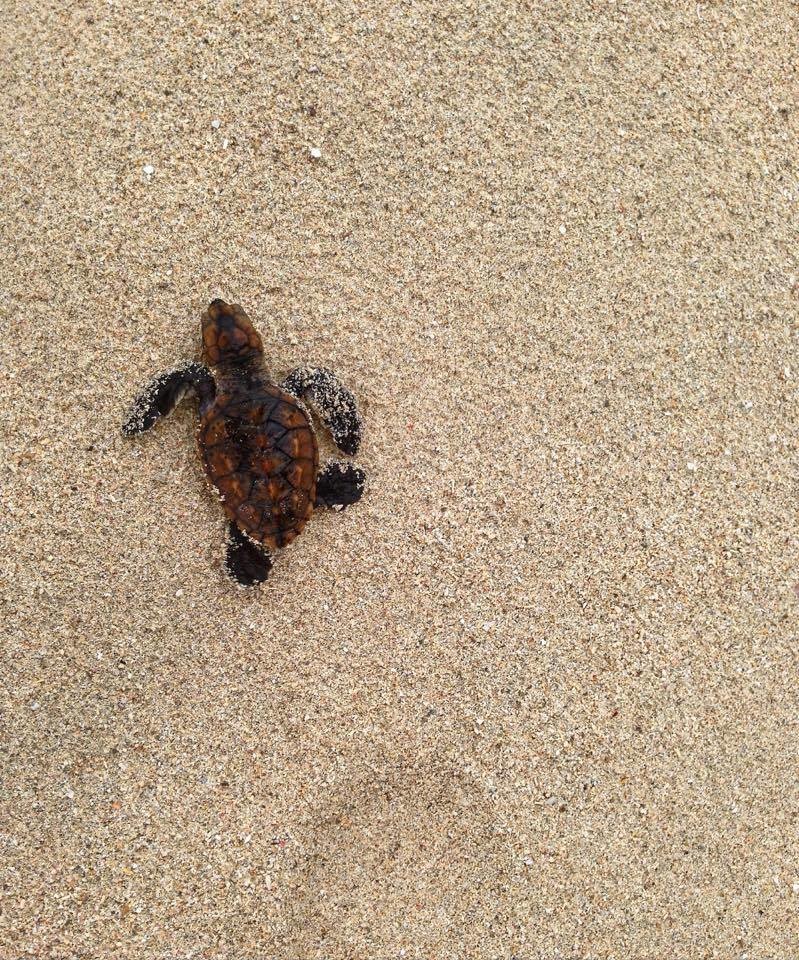
That same night my mom and I had a walk in Bocas Town, which is very pretty, as most of the hotels, hostels, bars or restaurants are pile-dwellings with water underneath. For the second time that day, as we were trying to find a value for money type of restaurant, we met David, an American professor and founder of the only international school in Bocas offering study and research on the animals and vegetation of the tropics. He has been going back and forth between Bocas and Panama City for around twelve years now. He just loved living in the heart of America, in the country of the biggest work of engineering that the world has ever seen: the Panama Canal, of spontaneous and hard-working people, and of the well-preserved indigenous tribe of the Kuna Yala. During our dinner in a Panamanian place that only offered roasted chicken and potatoes – which by the way was exquisite - David invited us to visit his home in Panama City and to stay with him for a couple of days. We decided to think about it, since going to the capital meant another 600 kilometers to cover by ride on the way there, and the same to come back.
On our third and last day in Bocas del Toro, we split the day for two visits. In the morning we went to Bluff Beach, a beautiful, long, sunny beach with an almost orange sand and blue, perfect waves. On the way to the beach, we jumped in the back of a pick-up, and we came back to town with an unusual ride: the police. In the afternoon, we decided to go to Carenero Island, which is just in front of Colon Island and there is always launches allowing the passage. At the dock, we met Mario, a young writer from Panama City, a very deep and philosophical mind. We visited together Carenero; we walked through the local villages, taking pictures of the things that were most meaningful to us.
While in the past the whole archipelago of Bocas del Toro was only the home of the native tribe of the Bokota people, nowadays it is also home to many foreigners who moved there attracted by the warmness of the tropics and it's very close-to-nature way of life. As I noticed during my stay, most of the people that come from abroad live in Bocas Town, on Colon Island, that disposes of most of the facilities and services necessary to host tourists. The interaction with the indigenous people on this island is becoming less real as tourism grows. I cannot say the same thing about Carenero, where it is still possible to walk through the towns and breathe the authenticity of the locals’ way of life. The place is still very poor, and inhabited only by the natives. They live in a very basic way, without proper hygiene, in dirty environments, sleep in huts, walk barefoot, throw trash on the ground, eat and play in the same place where chicken and cats... That is just how they live, but they are happy people. They enjoy the sky’s colors at twilight and the calmness of nature, they eat fresh fish every day and they swim in the clear blue water of the Caribbean Sea. They wake up every morning with the sounds of the jungle and they never force their biological rhythm, they share their piece of living space with the animals of the forest and their souls remain forever untouched by the chaos of the civilized world. How can they not be perfectly happy?
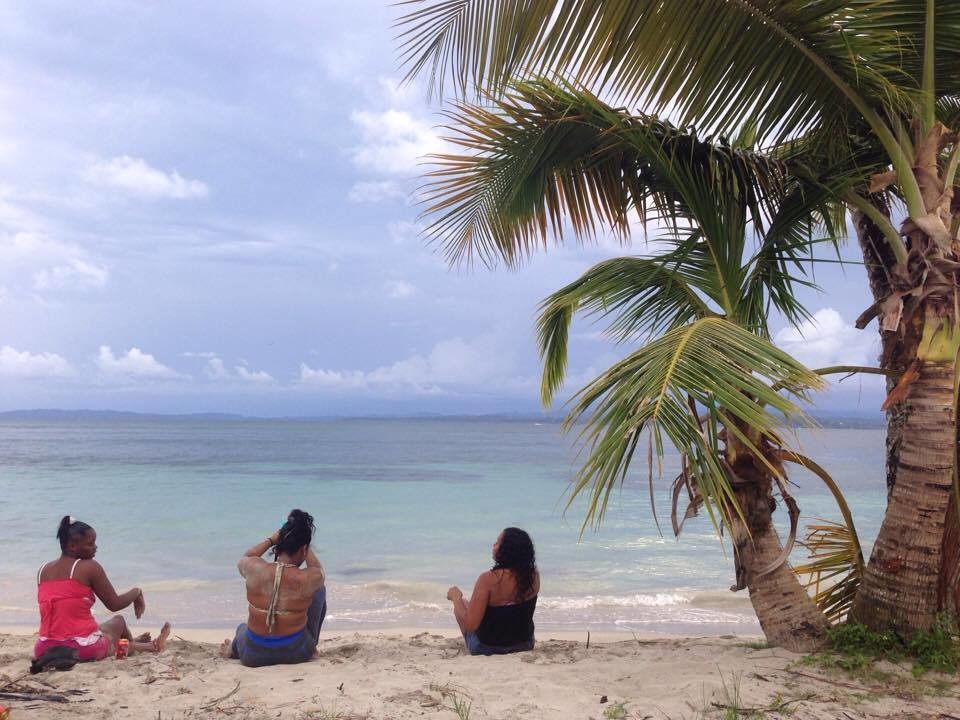
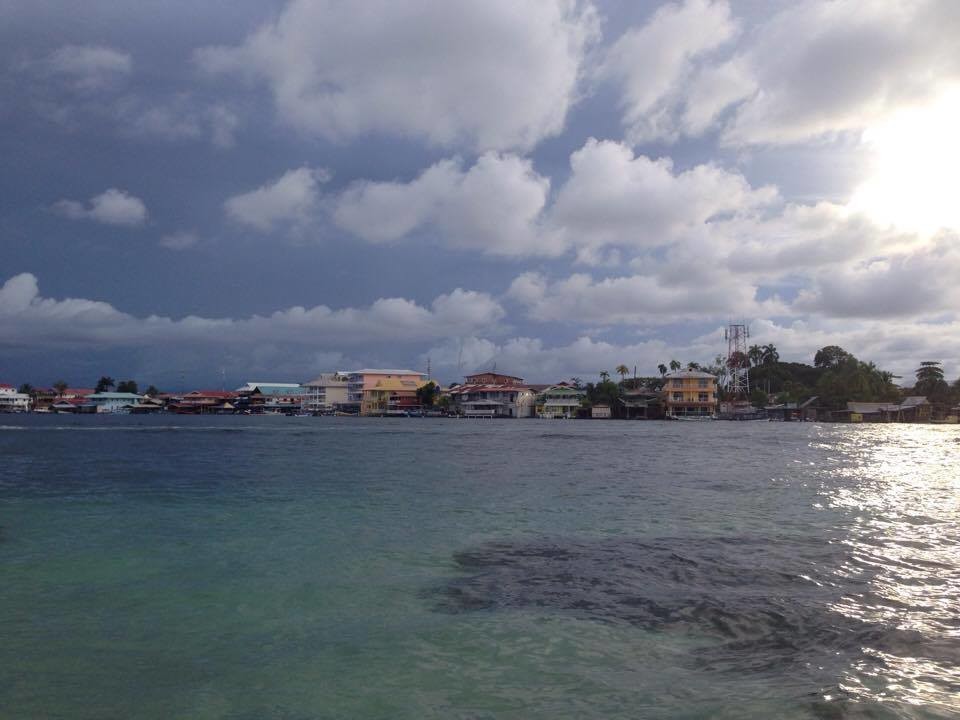
Panama, just like Costa Rica, is a country of contrasts where you can find very rich and wealthy people, some intellectual and educated people, and many other extremely poor and almost analphabetic. The contrasts make these countries very interesting, and as for nature, very beautiful.
Our stay in Bocas had been so intense and well spent, that my mother and I decided to discover more about the green country of Panama. It means that we were ready to cover 600 kilometers by hitchhiking in one day to get to Panama City where David, the American professor, was waiting for us. Three young industrial engineers from Barcelona on holidays stopped to pick us up, and in their company, we spent the journey with final destination perhaps the most beautiful city of Central America. As we had agreed on, David came to look for us in the center of the city and brought us to his home. He seemed very happy to see us, and he made us a delicious broccoli-shrimp risotto for dinner.
On the next day he took us to the most typical fish market in Panama City, where all kinds of people were walking, buying, selling, shouting, trafficking... Stalls were abound with different types of fish: big ones, small ones, huge ones, shrimps, mussels, clams, octopus..., it was all an abundant fish party, where everyone seemed to be already pre-tasting their dinner. One of the men selling his catch of the day was a Kuna Yala, an Indian native of the San Blas Islands, an archipelago belonging to Panama made up of more or less 300 kayos where these indigenous tribes still live and exist in a virgin and primitive way. They mostly dedicate to fishing, art making, children care, natural activities and in the recent years have started to open up a little to tourism.

After the fish market, we took a walk along the seafront of the modern part of Panama City. The tall skyscrapers are beautiful and suggestive, even if they make a big contrast with the rest of the country. It is a city with two souls: the city of the bankers, the businesspeople, the business owners, the traders, the managers..., but also the city of the less-rich Panamanians, the working, the poor, the educated, the non-educated, the white, the black, the mulattos, the good ones, and the bad ones. I was eager to discover more of this second soul, which is the most authentic and lively. We went for dinner in a local restaurant on the Amador Causeway, a narrow land bridge that connects the continent with four islands next to the Pacific Ocean entrance of the Panama Canal. This boardwalk hosts a variety of restaurants, bars, nightclubs, but also parks and sidewalks where people go for a run, a bike training and other sport activities. The Panamanian food was excellent, and the atmosphere was that of a warm, lovely Friday night. I perceived the city as a joyful, lively place, in my opinion striking and enchanting.
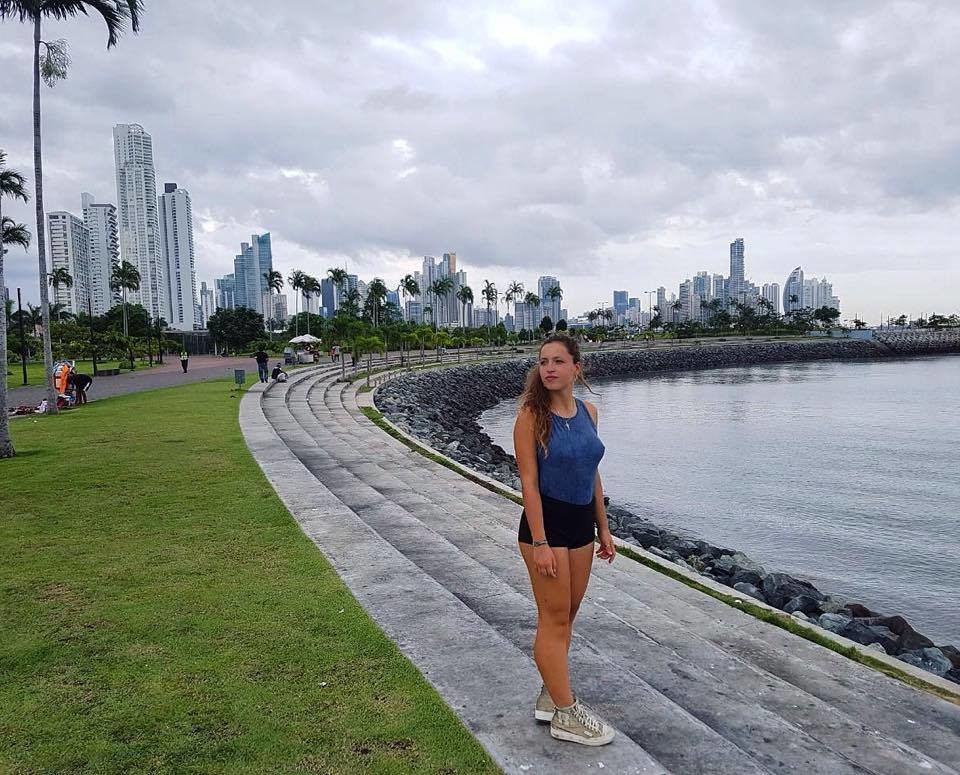
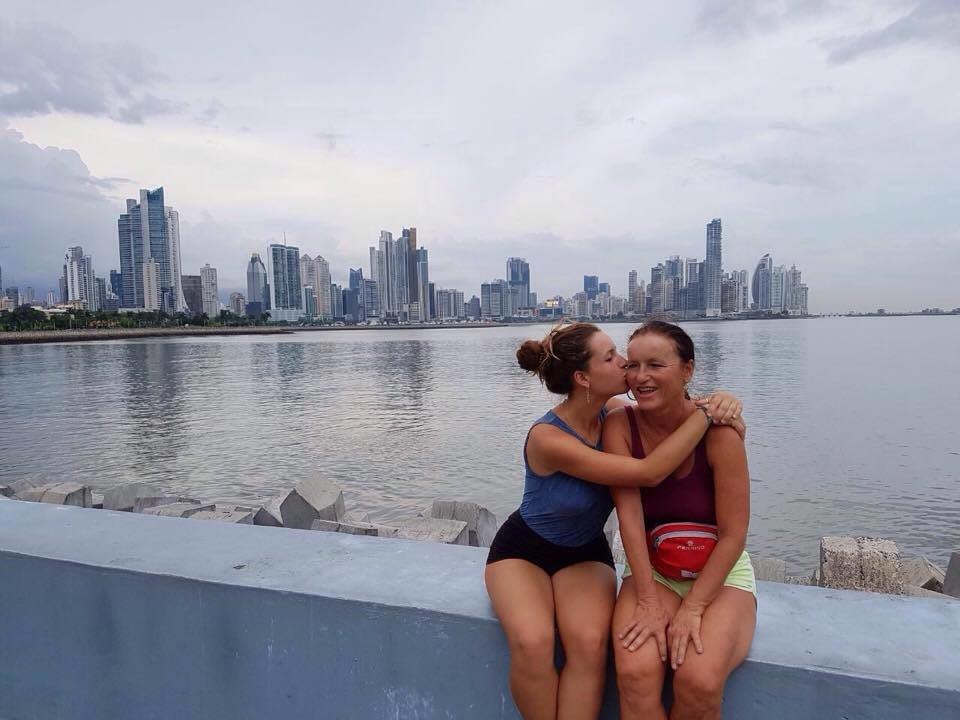

Panama City offers extreme contrasts, as I said it is the city of the non-Panamanians money-hungry super wealthy, and of all the normal, anonymous rest. Then it is the cutting-edge city of the ultra-modern, of the private investments and of the attractive millions, and on the left side of the fish market it the city of the old and the ancient, of history and architecture. Casco Viejo is the old city, with small palaces, squares, churches, homes and government buildings established during the Spanish colonialism. Nowadays there are many gourmet restaurants, museums, shops, residences.
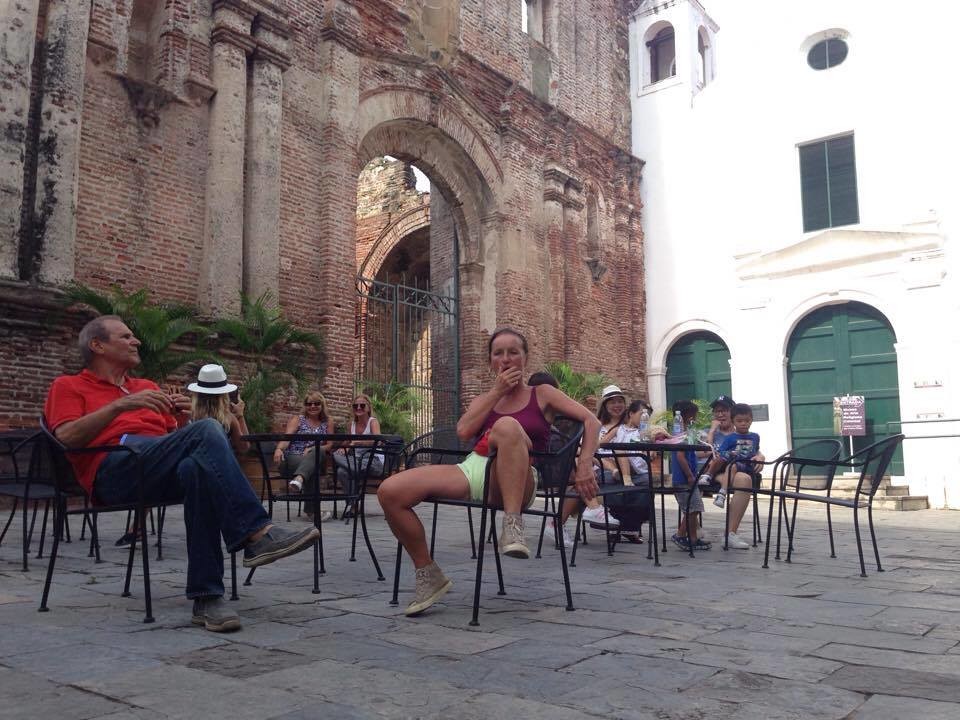

One of the most amazing things that we visited with David was without any doubt the Panama Canal. First, we went to visit the museum of the canal, where a short video explained how they built it, the system of the locks, the engineers and the workers that took part in the building, the efforts demanded, the time that they needed to construct it, and it's stratospheric importance. The Panama Canal is probably the most mesmerizing work of engineering that the world has ever seen. I was happy that were able to see a ship passing through the locks, leaving the Atlantic to meet the Pacific. I could not stop wondering about the incredible minds that projected it, that elaborated it and that turned it into a reality of world significance.
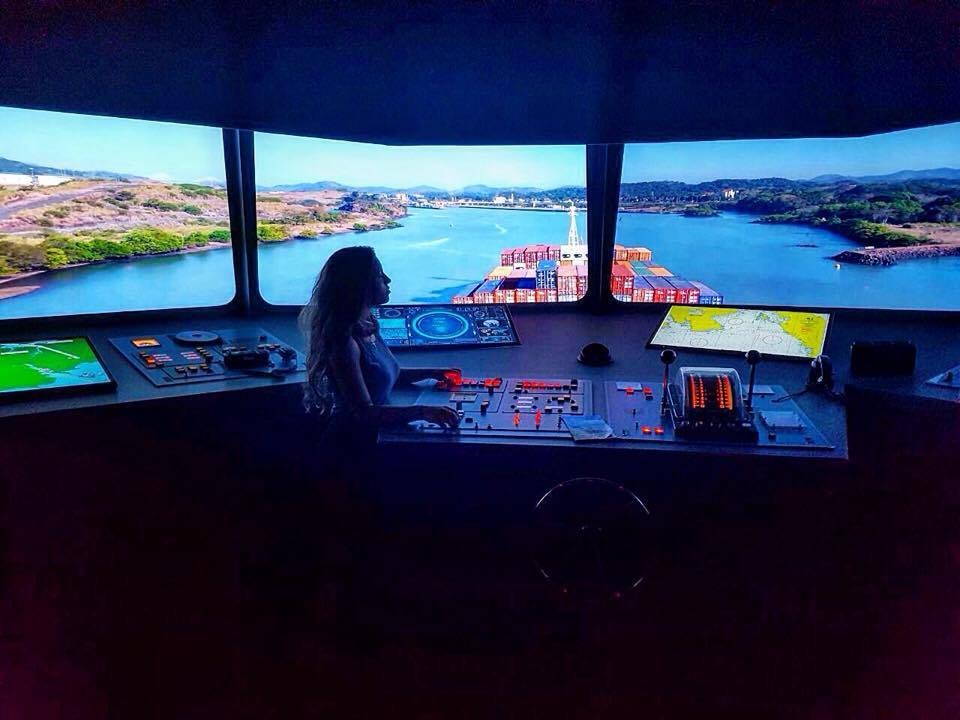
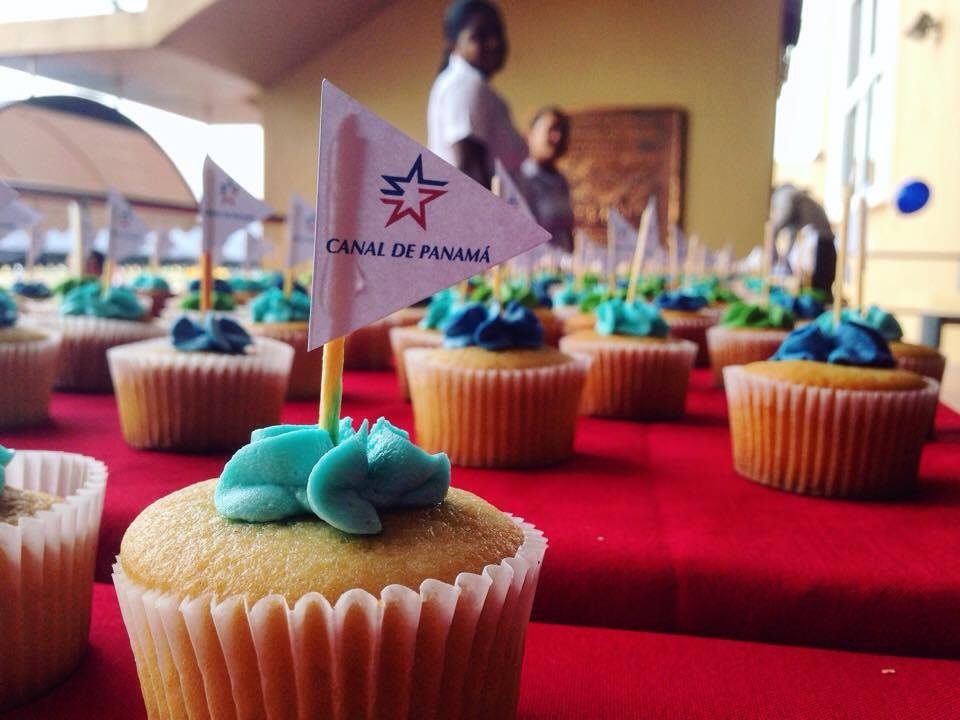
David also wanted us to see Portobello, a fortified town close to the Atlantic entrance of the Panama Canal mostly inhabited by local anglers. The road to get to Portobello passes through very poor parts of the country, visibly ruined and neglected, with mountains of garbage on both sides and very disregarded and dirty huts. Portobello itself is poor and simple, but there is a huge richness in artistic talent. Locals have painted each small house with strong colors and wonderful drawings. There are some exceptional murals, which make the village unique and expression of the natives’ creativeness.
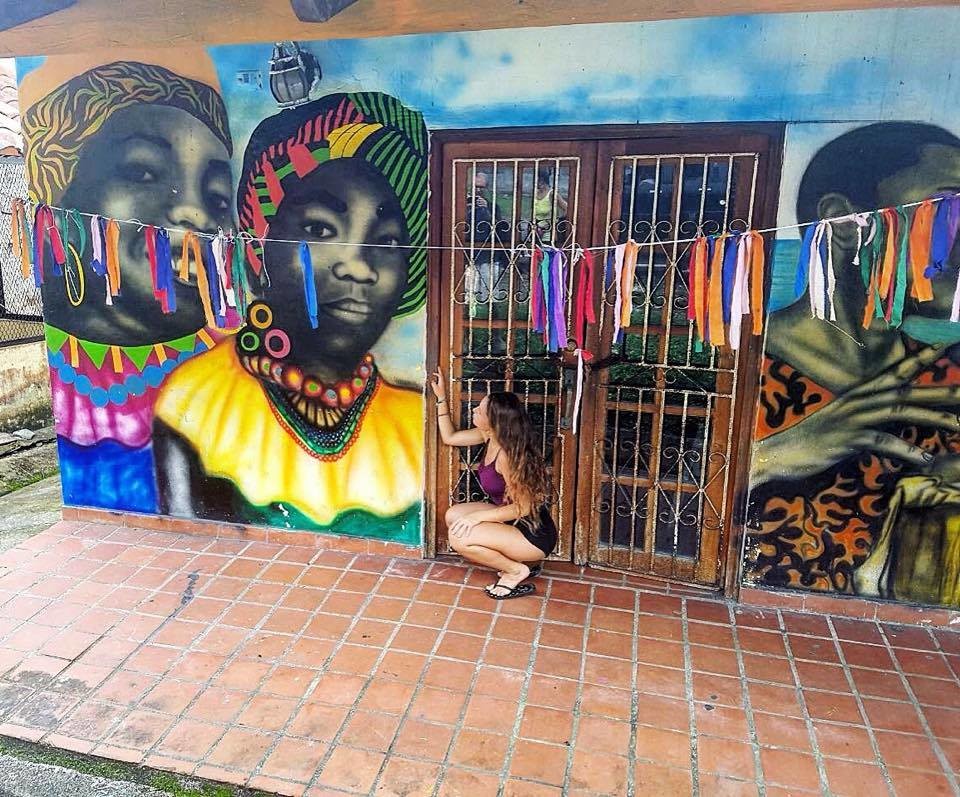
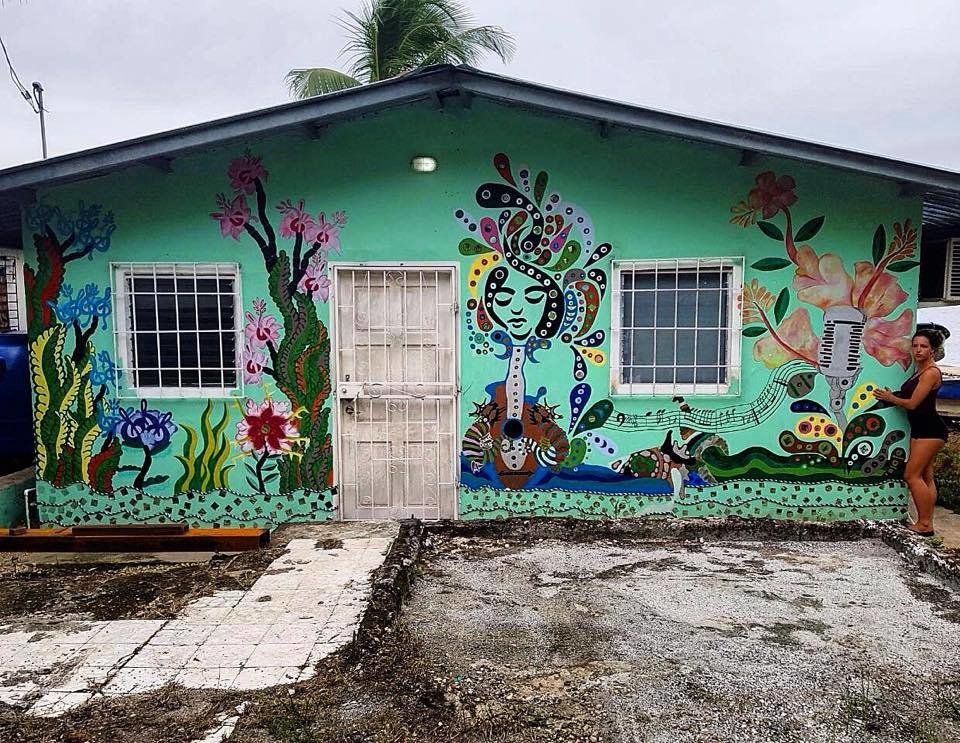
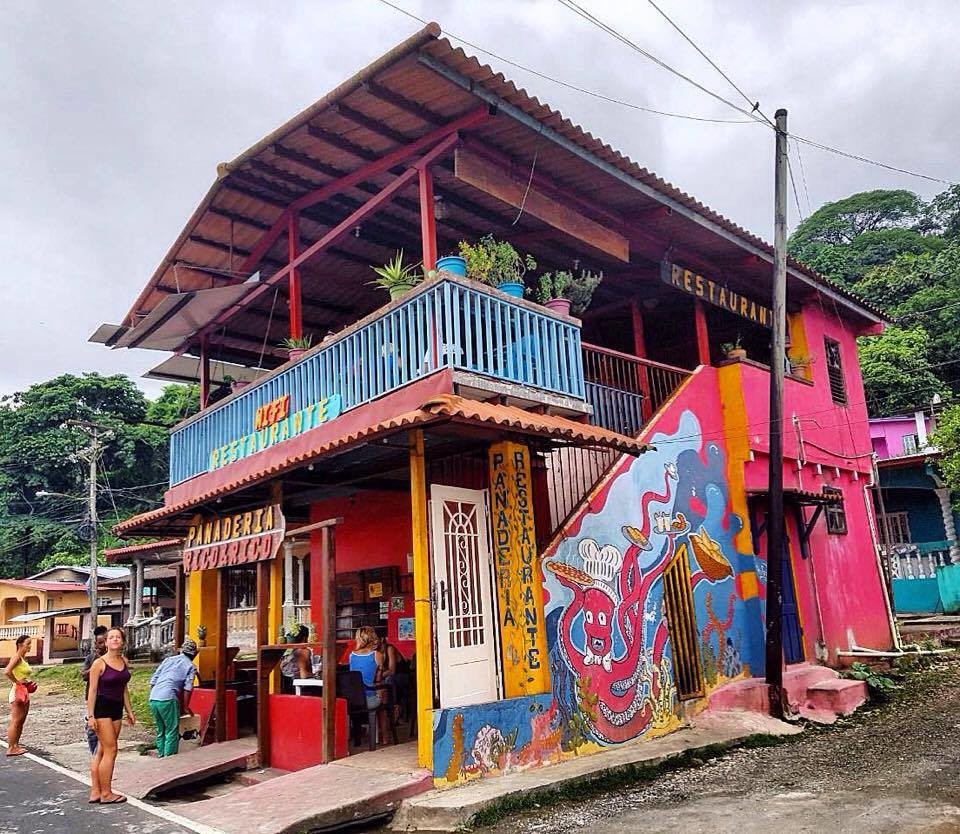
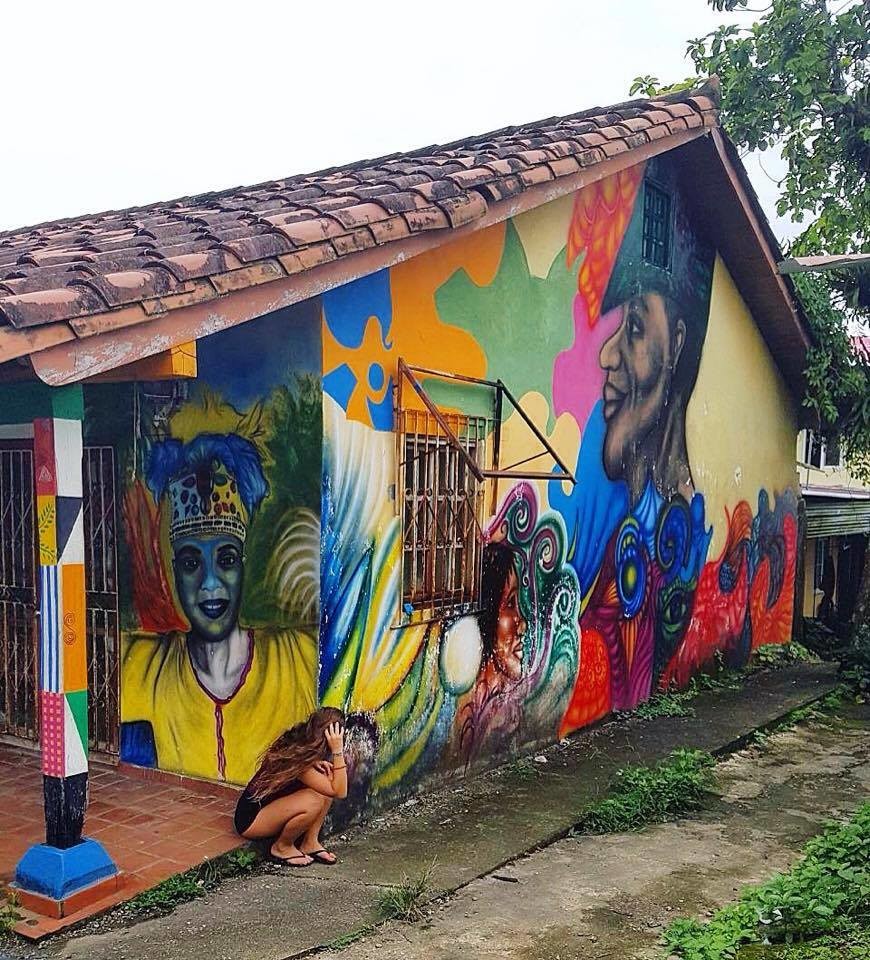
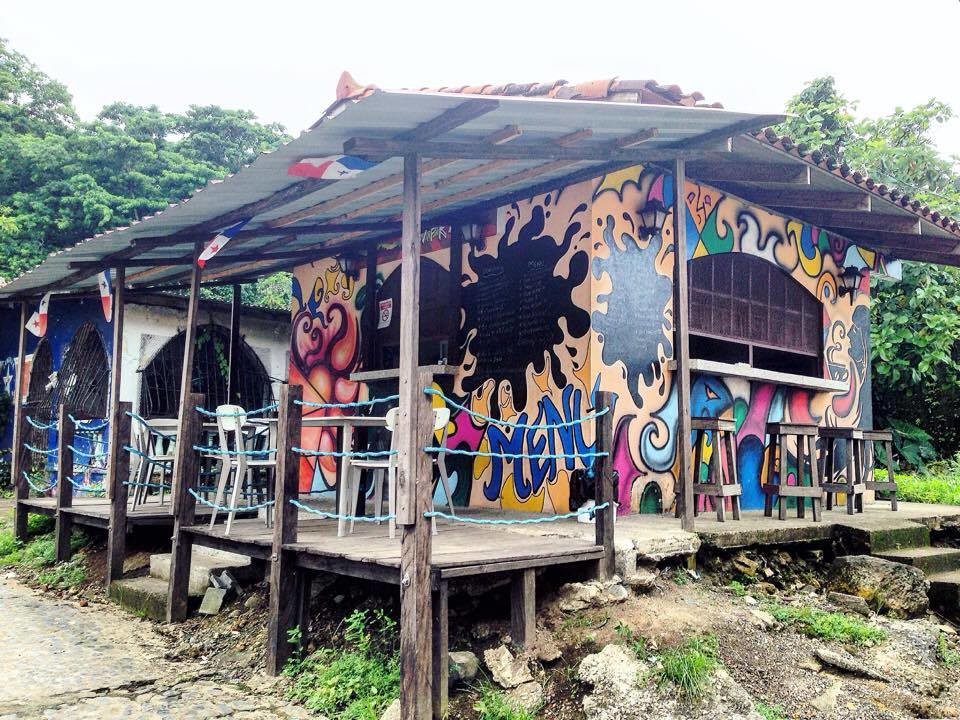
Time came to leave again. After three special days, my mom and I were hitchhiking again on the highway that is both an artery and a vein of the capital. Our next destination was Santa Catalina, a village on the coast of the Pacific Ocean of Panama, also point of departure for the visits to the National Park of the Island of Coiba. The man that gave us the next ride was Joe, a biomedical technician and ex-soldier in the US Army. He was renting a house in a coastal village of Panama and eating fresh seafood every day since his moving. He liked our company so much that instead of going back home, he came with us to Santa Catalina. We visited the local beach for surfers, drank a beer, ate fish, and on the next day he decided to come with us to Southern Costa Rica and visit Corcovado. He also had to buy some new clothes in order to continue the journey. Joe let me drive his car from Santa Catalina to the boarder, and for at least three hours, we drove through the green lands of Panama, on a road with nothing but trees, grass, green hills, and farm animals.

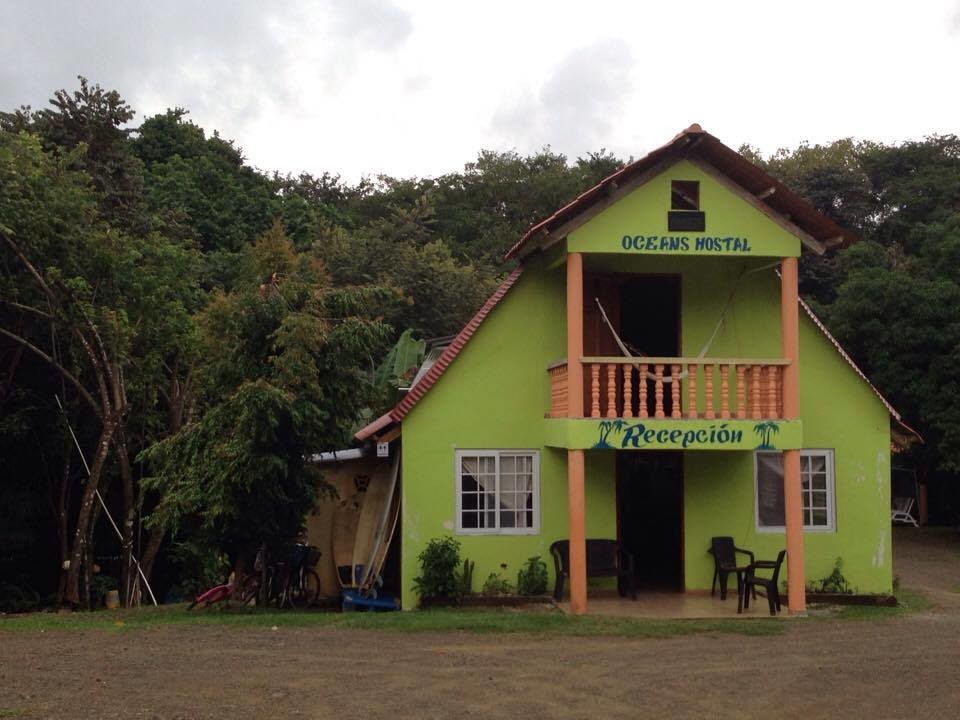
Customs officers did not let us through with Joe’s rented car, and the hard rain forced us to stop and spend the night in a town close to the Costa Rican’s Pacific boarder. On the next day, as we were crossing the customs, I met Fabio, a Kuna Yala from San Blas who gave me his contact in case I wanted to go and teach English to young kids and live in his community for some time. I will go, of course I will. I hope that I will be able to go during my fifth year of University. In Costa Rica, we rented a car for one day with Joe, and we drove to Golfito, where we left the car and mounted on a boat directed to Puerto Jimenez, the biggest town of the Osa Peninsula. The boat ride was fun, as the ferry was jumping over the waves and my hair was free in the wind breeze. This peninsula hosts the biggest and most flourishing tropical forest in Costa Rica, Corcovado, also called “the amazons of Central America”. It is also the wildest and most isolated part of the country, where few people live and few people visit. Reason why, in my opinion, it is the most mysterious, rich-in-biodiversity, and spectacular place of Costa Rica. It preserved it's beauty and it's wilderness, because it is less crowded, less commercial and less influenced by tourism.
Puerto Jimenez is nothing more than a seafront walk, a deck, a few houses, a few Spartan restaurants and cabins to host travelers, a few launches and fishing boats, but it's surroundings represent everything for nature lovers. A forty-kilometer dirt road, with holes, rivers and mud separate the town from Carate, where only a few wooden huts were built for those wanting to spend a night in the jungle. Carate is probably the most abandoned and isolated place on earth, considered the southern entrance of Corcovado. National Geographic considers this Park as “the most biologically intense place on earth”, where more than four hundred square kilometers of impenetrable vegetation border the most untouched beaches on the planet.
Only an hour walk from Puerto Jimenez there is Playa Diamante, a long beach with perfect waves that are not to be too trusted. There were maybe six people in total on the beach, us three and three local boys that were actually so nice to give us a ride back to town. I loved it there; I loved the simplicity, the calmness, the far-away-from-everything feeling. A day later, we sadly said goodbye to Joe, who took the ferry back to Golfito, while we continued our journey north. From Puerto Jimenez we found a ride with a man from Argentina, who owned a lodge in Drake Bay, the northern entrance of Corcovado. He told us that Drake Bay is very difficult to reach, either by an hour and a half boat ride, or by a two hours and a half dirt road with a car in four-wheel drive. He tried to lure us away from going because the dirt road that goes to Drake is very little frequented, and during rainy season – ours -, even less. Well, I did not listen to him. Everything he said, instead of discouraging me, convinced me that Drake was worth seeing. I told myself this: “what is difficult to reach, is usually very precious once you get it”. The man told us that nature makes it hard to get through, and this means that only nature lovers take the risk. Not intentionally, he had woken up my interest, my curiosity, and sense of adventure. Therefore, he left us on the crossroad with Drake Bay, wishing us good luck in finding a ride. My mom and I told each other that if no one showed up in the next two hours, we would give up the place and continue north. It seems luck was on our side for the entire journey, counting that not even fifteen minutes later we were already sitting in a car with three young women architect from Barcelona. Destiny wanted that we see the area.

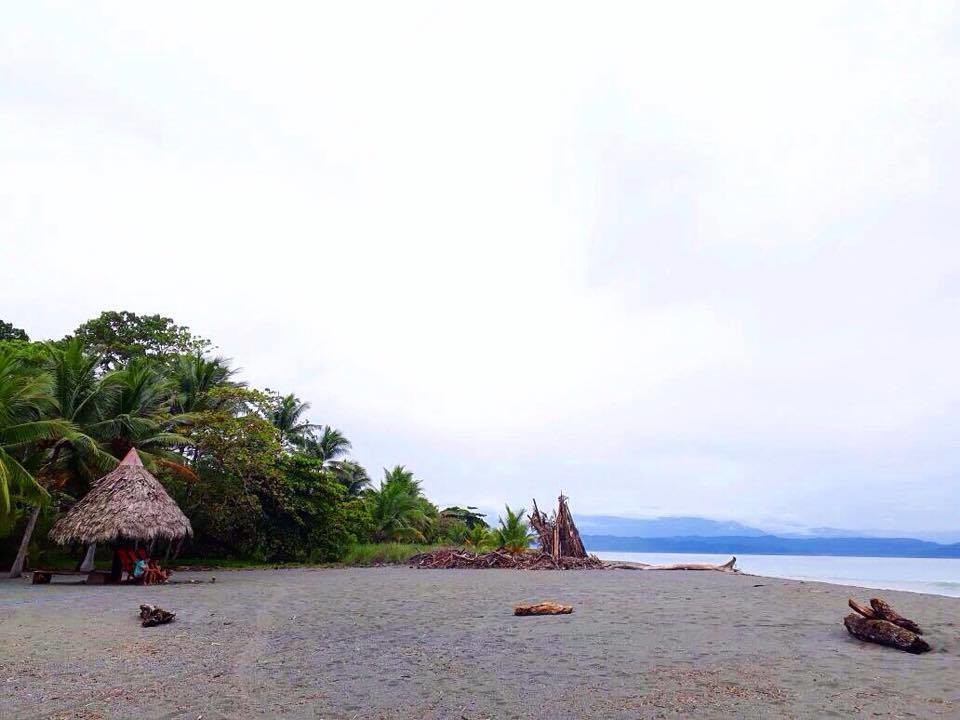
I knew Drake Bay was far and that the road was bad, but I did not expect that much. It was about fifty kilometers of an impossible dirt road, narrow, with constant curves, deep holes, big rocks, mud, tree trunks, brooks and rivers. A few times, we had to get off the car, walk through the rivers with bare feet to check whether the pneumatics would make it or sink and eventually accelerate to cross them. We did it at least four times. At some point, we reached a large and deep river, where a lorry had sunk in the pure middle. The three girls, exhausted by the environment, told us to leave and that we had arrived to where we wanted, and left us there on one side of the river in the unknown jungle of the Osa Peninsula. Shortly after, a man with a big forest truck stopped by and told us that he knew how to cross the river and that he would take us to Drake Bay, his home. We mounted in the truck and went to pick up a man from Serbia and a couple from England at the tiny airport of the Peninsula. The intense tropical vegetation represents a significant obstacle in this region, makes it so hard to cross, that local people have built this mini airport to facilitate the passage for travelers and for local University students. The airport consists of only one runway, and the plane has maybe six seats in total. It lands in the middle of the jungle. After we picked these people up, we were able to cross the large river in a way that only he knew how, with half of the wheels underneath the running water. I thought we would arrive shortly once we overcame the obstacle, but in fact, we still had more than one hour drive ahead of us. The road was as narrow as the last one, but with more ups and downs like on a roller coaster. I could not stop laughing as I was looking at my mom’s shocked face.
Finally, after what seemed to be an endless drive on holes, rivers, mud, rocks..., we were rewarded with the spectacular view of Drake Bay. The town of Drake lies on a steep hill, with no asphalted roads, only rocky and bumpy ones. Simple restaurants and grocery stores can be found on either side of the main serpentine road that from the beach at sea level builds up to the top of the hill and continues to reach other more isolated towns. The town dislocated on the hill with the long curved beach at it's feet creates a bay that hosts dream shades of sunlight, and at night, an ablaze dome of brilliant stars that I have not seen anywhere else in Costa Rica. The Bay is like a hidden treasure, protected by acres of jungle, and this is the reason why many animals find it a safe place to live. Red parrots fly freely, monkeys eat and jump everywhere, and I even saw a big land turtle walking on the side of the road during the darkness. Apart from jungle animals, every year Drake Bay is also the favorite stopover for marine animals, like dolphins, marine turtles and whales, during their journey of migration and reproduction. There is more dolphins and whales in this Peninsula, than in any other coastal area of the country. I also met warm, gentle and interesting people down there in the South, people that are in love with wild nature and the ocean. The Osa Peninsula also welcomes many worldwide scientists who study forests, marine biology, zoology, and other fields.
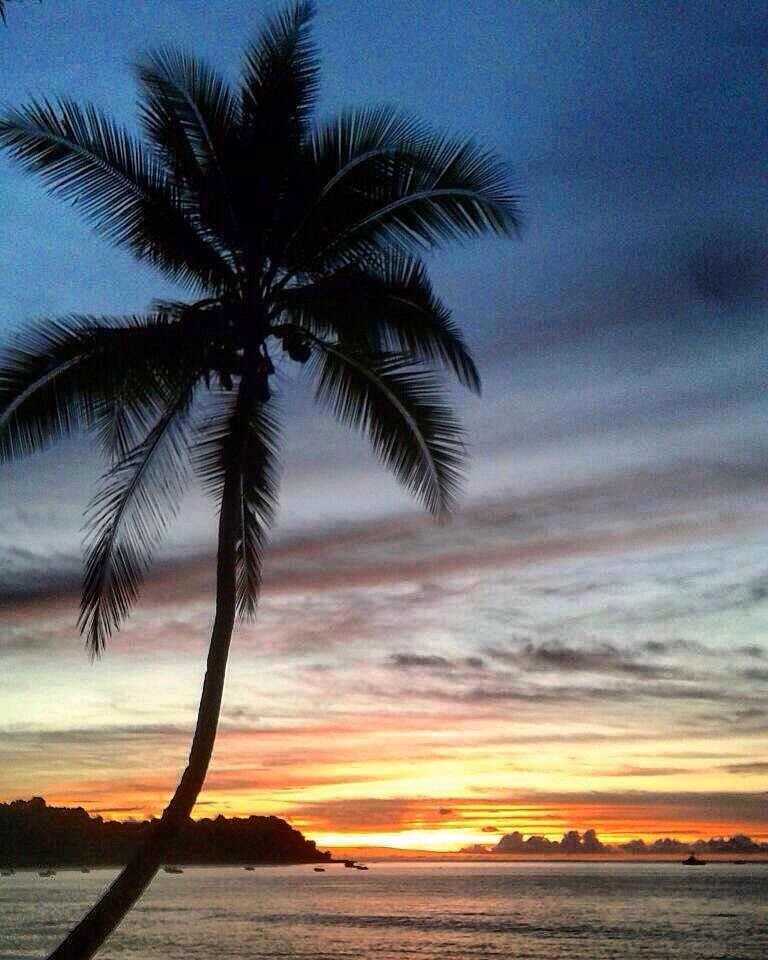
The man that helped us cross the river and that took us to Drake Bay showed us the few lodges that he owned to see if we wanted to stay there for one night. Because the place was so unique, we decided to stay two nights in his lodge. It was on top of the hill, with a balcony bending over the vegetation, with the forest all behind the house. His family lived next door, so we felt like being part of it. Thanks to the few rooms that he rents out to travelers, he can afford to pay University for his children. I could see that they were more educated than the majority of Costa Ricans. They had more of a European mentality; I could sense ambition in his daughter’s words, plans for the future, desire to pursue a working career, love for books and study. It is rare to find this in Costa Rica, because the majority are still more primitive minds.
On the next day, we decided to wake up early and go for a hike from Drake to Playa San Josecito, which is around three hours of walk. If you ever go to Drake Bay in your life, then this trail is a must-do. The path goes through the jungle but borders the coast, so it also gives the chance to visit the little beaches and bays that exist peacefully between Drake and San Josecito, and that only local people know. We walked through the tropical vegetation, surrounded by huge trees, where even the smallest bush is still taller than I am, in silence to hear the sounds of the forest. We crossed one blue river on a hanging bridge as it was in a sort of canyon, to meet the path again on the other side. I would like to precise that some small rivers in Costa Rica are of a very strong color - green mixed with light blue – that we can describe as celeste, and the reason lies in the chemical reaction between the minerals in the water and the sunrays. The second river that we met, again of this very particular color, presented more traps than the last one. The only option for us was to cross it on it's estuary, but the ocean’s high tide at that particular hour had filled it so much that in most parts of the river, I could not touch the bottom with my feet, and we had two rucksacks with us. I managed to get one rucksack on the other side by swimming with my arm lifted in the air, but with the second, I was afraid for some personal stuff that could not get wet. We were lucky again, as at that exact moment, Alvaro, a friend that I had made in Drake Bay, appeared with three Canadians swimming in the river from it's waterfall to the estuary. He helped us cross, and on the other side, we drank a hot cup of tea that some locals had prepared for the three tourists. On our path to San Josecito, we met howler monkeys, playing above our heads, some wild turkeys, and small, fat, intensely red birds. When we finally go to the beach, we had a relaxing swim in the clear water of the bay, and asked to a local dreadlock boy with a sweet smile, if he could give us a ride back to Drake on his boat. He had accompanied on a diving tour a young couple of teachers from Spain, and now they were having a pic-nick on the beach. He was happy to give us a ride back and he even offered us the lunch that he had prepared. On the boat ride back, we saw a marine turtle.

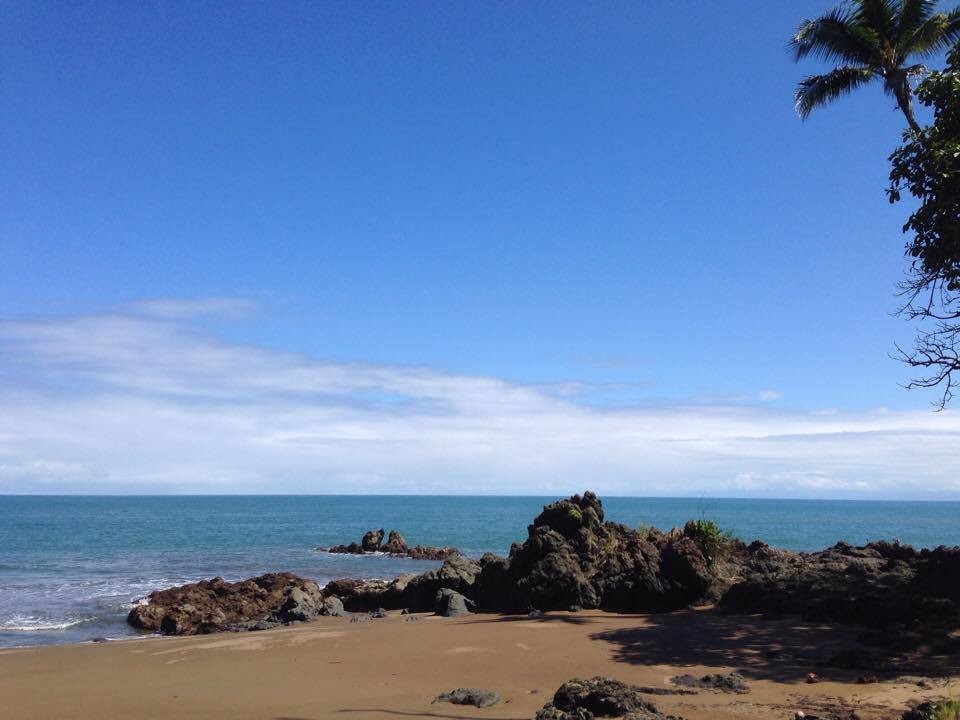
At six o’clock in the morning on the next day, we woke up with the sounds of the forest, attacked by some little, fascinating and exquisitely cute creatures. Maybe thirty cappuccino monkeys, some with babies on their backs, started jumping on our balcony looking for food, as the granny of the family was feeding them. Whiteface monkeys are curious and hungry, but they respect you if you earn your respect among them. They will grab your food only if you willingly give it to them. Since it was very early, we went for a swim to the local beach, and then waited for Alvaro to drive us to Sierpe, through the jungle again. The drive to Sierpe was fun. We crossed a couple of rivers again, stopped to look at the land of the mangroves in the distance as were going uphill, and for a coffee in a place on top of a hill that had a 360 degrees view of the inland area of Sierpe. The place belonged to a local farmer who had built three open bungalows, equipped with a bed and a hammock, each one with the view of the ocean far away and of the immense green land stretched as far as the eye could see. Once we arrived in Sierpe, we crossed the last river. There have been so many that I gave up the counting. This last river was much bigger, so we needed to wait for a local boy to move a floating platform to the other side of the river so that we could put the car on and reach the road on the opposite side. For me, this river meant a frontier that separates the wilderness from the more civilized and urban world. That same night, three locals with a dog accompanied us to our hostel in Uvita.
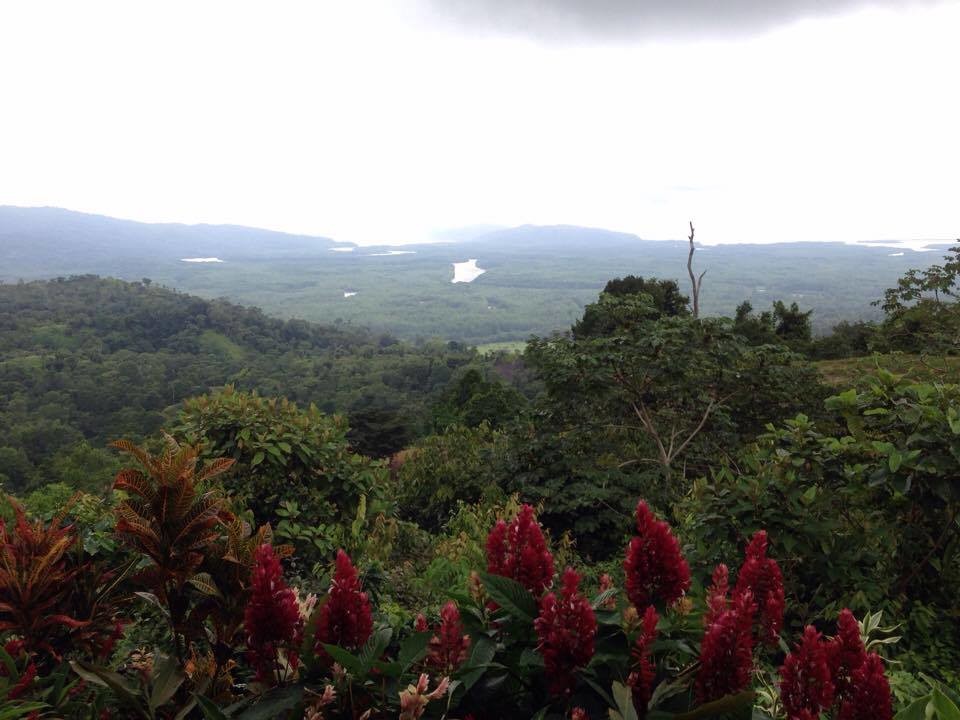
Early the next day, my mom and I found a ride to Puntarenas with a local lifeguard. He was travelling the country to give lifeguarding courses to the rangers of all the Parks that border the ocean. An awesome job, right? Once in Puntarenas, we met a seventeen-year-old Costa Rican girl, who was going to Montezuma, in the Nicoya Peninsula, just like us. We took the ferry from Puntarenas to Playa Naranjo for a two-hour journey with the last shades of sunlight kissing the ocean. When we got off the ferry, we mounted in the box of the pick-up of that a young man and his mother were driving. They were from San José, the capital; he is as a fraud investigator for Amazon, while his mother is retired. My mom, the girl, and I sat for three hours in the box of their pick-up, jumping with the vehicle as it encountered holes and rocks on the impossible dirt roads of Costa Rican wild territory. It was already dark, and I had the sensation of being lost in the middle of nowhere. I could feel the chilly wind of the night, giving unpleasant goose bumps to my naked legs. I could feel the pressure of the night on my thoughts, as they carried me in the world of crimes and horror and blood. I could only see dark interminable fields all around me, the only light being the headlights of our car. Despite these thoughts, I felt perfectly happy, as I would love to live my entire life. Always on an adventure, always travelling, always inhaling the air of the unknown.
Eventually, we reached our destination: Montezuma. Montezuma is a coastal town, where perfect waves come to die, for the joy of the surfers. It is a touristic village, with an ideal position because it is close to one of the most breathtaking beaches of Costa Rica, Playa Santa Teresa. During the night, it rained non-stop, and in the morning, the ocean was brown and agitated, for all the dirt that the rivers had carried to it's waters. We decided to go visit the waterfall, for which Montezuma is particularly famous. One problem arose though: it had rained so much that the river was overflowing with brown, tumultuous water. In order to go see the waterfall, we needed to cross the river, but it was too rough from the regular path. Luck was on our side once more, as we met a completely nuts, local guide, Crazy Carlos, who had pity on us and decided to give us a birthday present: guide us to the waterfall from a private path. Crazy Carlos was an amazing guide; he guided famous people like actors, too. We descended a steep and narrow path to reach the edge of the river in a part where it was flat; we took off our clothes and jumped into the brown water behind him. We walked barefoot on sharp rocks on the other side of the river to get to a flat rocky platform in the middle of two waterfalls, a small one, and a huge one. The huge one was a bomb of water, sprinkling in every direction like crazy, with a power that only nature knows. Costa Rica is the country of the adventure, of the unexpected and surprising.

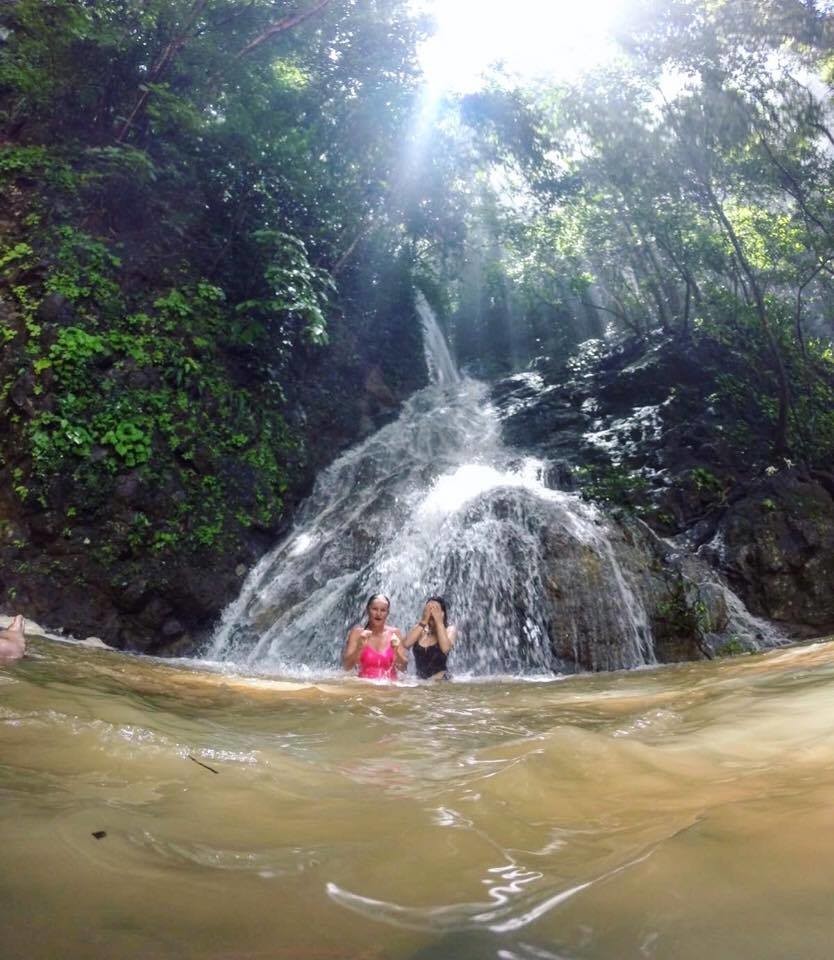
On the same afternoon, we moved to Playa Santa Teresa, a four-kilometer long beach with spectacular waves and wondrous sunsets. Sunsets are so incredibly colorful, warm, and fabulous in Santa Teresa that even words fail in the attempt to describe. Young travelers, tourists and locals, cluster at sunset in a place called Banana Beach that works as a bar and a restaurant, where they sip beer or cocktails until the last colors of the sun leave the sky. The town of Santa Teresa in nothing extremely special, it is just a long road with hospitality businesses owned by strangers and restaurants offering different types of food. The beach, though, is another world. It makes you dream, imagine and wonder.


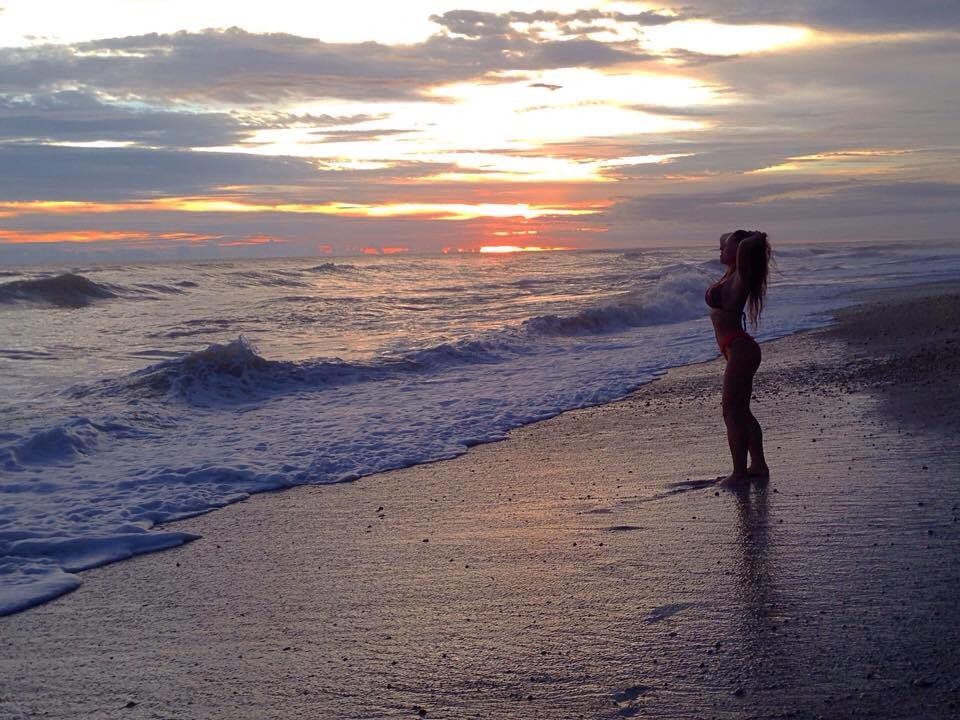
From Playa Santa Teresa we came back by ride with Claudio, an engineer of communications from Honduras. We spent the entire day with him, as he drove us all the way back to Tamarindo, from where our journey had started. Since he had work to do, go check some places to see if it was possible to build a telephone communication tower, we accompanied him, and then we stopped at a beach called Playa San Carrillo, a bay with perfect palm trees and amusing waves. Claudio lives in Alajuela, a town close to the main airport of the country. He is an intelligent man, who loves rock and metal music, and he has a handsome smile.
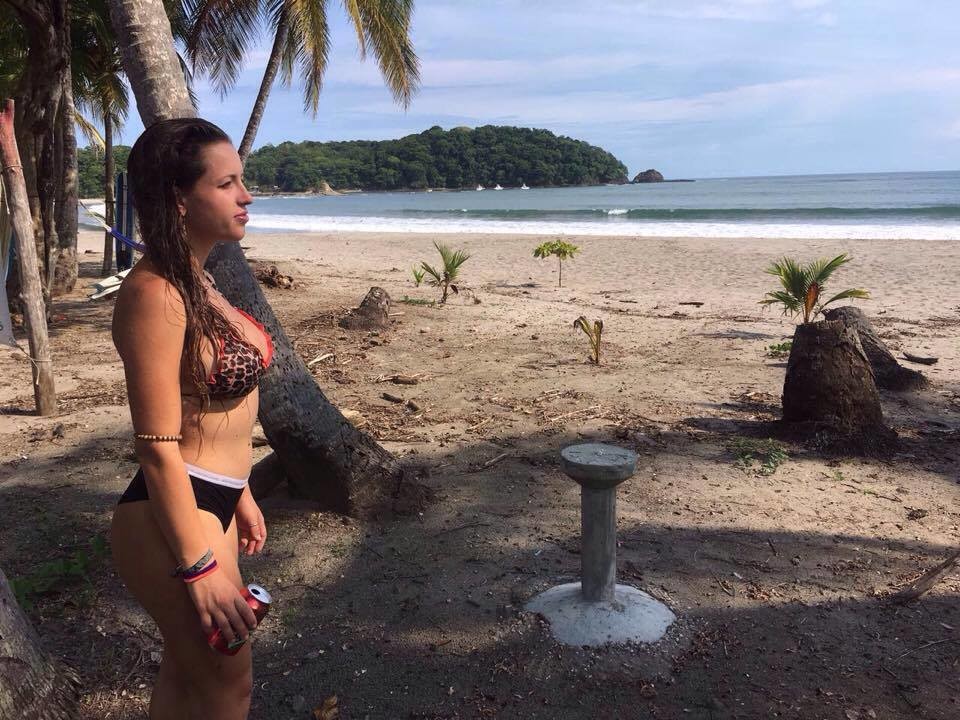
Our journey started in Tamarindo, and ended in the same place, but I felt enriched in experience, in traveling, in cultural awareness. I will never be able to forget a journey like this one that made me feel alive and perfectly happy. I have hoped that I will make travelling my life, my goal and my everything.
Photo gallery
Content available in other languages
Want to have your own Erasmus blog?
If you are experiencing living abroad, you're an avid traveller or want to promote the city where you live... create your own blog and share your adventures!
I want to create my Erasmus blog! →












































Comments (0 comments)